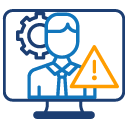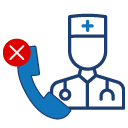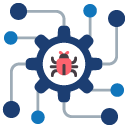ATSG’s Unified Communications & Collaboration (UC&C) Management
Assuring Complex UC&C Environments with The ATSG OPTX™ Network Management Platform
Unified Communications and Collaboration (UC&C) via voice, video conferencing, screen sharing, instant messaging and electronic white boards, enable employees to perform business tasks quickly and efficiently. Such solutions also increase productivity and improve teamwork across geographic locations, while reducing travel expenses and wasted time.
If implemented correctly and integrated with other business applications like contact centers, UC&C solutions allow for better communication with customers by providing a consistent interface across different platforms, and seamless transition through the communication chain.
UC&C can also help companies provide better customer service, as it enables real-time information sharing on multiple channels and allows customers to choose the most convenient method for them to communicate with you – all of which helps maintain customer satisfaction.
UC&C relies on many different components to deliver the services your business depends on. Any problem with the network, servers, business applications, communications media, endpoints or consumer applications, that are part of the system, will cause performance degradations or outages.
In this complicated environment, it can be very time consuming to troubleshoot problems using the typical assortment of point tools. Further, troubleshooting efforts often lead to finger pointing between groups, which further delays the solution and negatively impacts the business.
ATSG OPTX™ Network Management Platform Capabilities
The ATSG OPTX™ Network Management Platform provides predictive and proactive business service assurance across hybrid infrastructures, with actionable intelligence for prioritizing and addressing problems, before they impact critical business services.
This protects revenue, improves customer experiences, and reduces IT costs. The ATSG OPTX™ Network Management Platform manages UC&C environments – end to end and top to bottom, including all the supporting infrastructure.
Modeling UC&C as a business service, it can provide true root cause analysis (RCA), predict impending problems, and also prioritize problems based on the impact to the business. In addition, it provides specific UC&C management functionality to help find and solve problems that can be hard to track down, and often go unnoticed with other tools.
Management and Troubleshooting Challenges
The value of proactive service assurance – in other words, ensuring the operations team knows about an issue before users report it – is more important than it may seem. The fact is, oftentimes issues are never reported by users – or, if they are, it is because they are persistent.
Quick Links
Contact Us
Learn More About Managed Network
Typically, when degradations or outages occur, users will stop what they are doing and then try again, or simply give up and use a different medium, as they assume the operations team already knows about the problem. In addition, they’ll typically complain to their co-workers about the technology or the IT department, which only wastes more time.
Common UC&C Issues and Causes

Dropped Calls
Commonly caused by network firewall or routing problems, WAN degradation, network configuration issues, call server configuration issues, and SBC configuration issues, failures or performance.

Poor Voice or Video Quality
Commonly caused by network problems or misconfigurations, call server misconfigurations, SBC misconfigurations, and endpoint device problems, misconfigurations or location. Voice or video codec selection issues with a conference bridge also cause poor quality.

Single User Problems
Issues such as one caller creating unwelcome noise on a conference call, or a single user not being able to hear anything are often caused by problems with the network, end device, call server or SBC. All could be due to misconfigurations or faults.
The ATSG OPTX™ Network Management Platform
The ATSG OPTX™ Service Assurance Platform provides full-stack monitoring, with end-to-end, top-to bottom management for the Cisco UC and Collaboration infrastructure. Advanced analytics and root cause analysis (RCA) predictively and proactively detect new and impending problems, and quickly analyze them from multiple angles to find the true cause and provide actionable intelligence.
With business service monitoring and prioritization, these root cause problems are prioritized, based on the criticality of the impacted business services to ensure the most important problems to the business are addressed quickly. Streamlined remediation and management workflows reduce mean time to repair (MTTR) through automation. Secure, multi-tenant remote access further reduces MTTR by enabling experts to rapidly solve problems.
Further, these UC&C specific management features are seamlessly integrated into the ATSG OPTX™ Network Management Platform, allowing for all the platform’s core features – such as Root Cause Analysis (RCA), Business Impact Monitoring (BIM), Smart Analytics and the Service Management Infrastructure Layer (SIML) – to be applied to UC&C systems.

Using the ATSG OPTX™ Network Management Platform to Solve UC&C Issues
The ATSG OPTX™ Network Management Platform solves a variety of UC&C issues, including problems with call managers, gateways, endpoints and the underlying route/switch infrastructure. A sample of those problems and the applicable ATSG OPTX™ Network Management Platform features that solve them are outlined here.

Call Quality
The ATSG OPTX™ Network Management Platform contains a Call Quality Dashboard which shows historical CDR/CMR data. It includes statistics on number of calls, jitter, latency, packet loss, MOS and resource constraints that are used to show configuration issues or capacity problems. It also includes location based reporting, with a Collaboration Quality Dashboard that displays which locations are communicating with which other locations and tracks statistics.

System Use and Misuse
The ATSG OPTX™ Network Management Platform’s dashboard statistics provide data needed to make business-level decisions, such as determining how to best utilize a certain technology. For example, these dashboards can indicate whether people are using expensive telepresence rooms to communicate with others at different locations, or if they are simply using the telepresence equipment in those rooms as local displays for people that are meeting face to face in the same room.
This information enables the company to make a decision on how to maximize their investment in telepresence equipment – perhaps by redeploying the equipment to a more useful location or by providing employees training on its proper use.

Capacity Problems and Capacity Planning
Trunk Traffic Reports show capacity on physical and logical resources such as SIP trunks. These can be compared against errors, such as media resource exhausted alerts, that trigger even though the trunk may only be running at 30% capacity. In such cases, the ATSG OPTX™ Network Management Platform allows further troubleshooting to be conducted, to determine if the problem is being caused by a segmentation and policy configuration error or if there is a device issue.
Trunk Traffic Reports also show the busiest times of the week and month, as well as peak loads – information that is important for capacity planning purposes as it can indicate if additional bandwidth is required or if a reduction is possible to help save cost and still maintain call quality.

Availability and Performance
Since calls are controlled by humans, it can be hard to determine if short calls, connection failures and other problems are caused by human activity – for example, because someone placed a call then immediately hung up – or by technology. Such problems can also be brought on by outside forces, like a call quality issue caused by environmental background noise.
How the ATSG OPTX™ Network Management Platform Improves UC&C
The ATSG OPTX™ Network Management Platform provides predictive and proactive business service assurance across hybrid infrastructures, with actionable intelligence for prioritizing and addressing problems before they impact critical business services to protect revenue, improve customer experience and reduce IT costs.

Healthcare Provider Discovers Dropped Calls
In many cases, implementing the ATSG OPTX™ Network Management Platform has provided immediate results by uncovering problems organizations were unaware they even had. For instance, one large healthcare provider implemented the ATSG OPTX™ Network Management Platform, and quickly discovered they were dropping 25,000 calls per day due to a configuration error.

Distributed Organization Un-earths a Gateway Bug
In another example, a distributed organization had been unsuccessfully trying to solve a problem for 18 months, with many people involved. Within two weeks of implementing the ATSG OPTX™ Network Management Platform, they were able to isolate the problem to a gateway bug then resolve the issue.

Experience the ATSG Difference
The ATSG OPTX™ Network Management Platform has also enabled service providers looking to offer hosted unified communications to their customers, to correctly monitor these services, ensuring success when they bring them to market.
Whether being leveraged to solve known problems, uncover unknown problems, or roll out new services, the ATSG OPTX™ Network Management Platform is critical to successful UC&C management.

